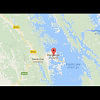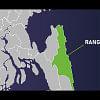Warning falling on deaf ears
A signboard on a corner of Simultoli ominously declares: “Identified as a landslide-prone area. Settlement prohibited.” A sudden clap of thunder increases the sense of foreboding.
However, despite the warnings, over twenty homes still dot this village in Rangamati municipality area.
As news of the latest landslide trickles in, the sense of panic grows.
“Now that the rains have started in Rangamati, we are already spreading awareness and asking people not to live in risky areas during the heavy showers,” the Deputy Commissioner of Rangamati, AKM Mamunur Rashid told The Daily Star.
He said 31 hills in the area, home to around 600 families, now display such signs.
Senior meteorological research officer at the district meteorological office Kayching Nuo Marma said about 142.7 mm rainfall was recorded in the first 15 days of May.
Last week alone, the district recorded up to 40 to 50 mm.
District administration officials said many families affected by last year's landslide started living in the at-risk areas again.
This correspondent visited many hilly areas in Rangamati town, including Notun Para, Simultoli and Rupnagar, where many houses collapsed in last year's landslide. All the areas had the same warning sign.
Mohammad Nurul Islam, a resident of Simultoli village, said he was a victim of last year's landslide. He was currently building a new wooden house to replace his old one which was swept away during the calamity.
He still lived in fear every day.
“We couldn't sleep properly when the heavy rainfall began. We don't want to lose any more lives like last year” he said.
Elsewhere in Rupnagar, three members of a family died in the 2017 natural disaster. But the rest of the family returned to the same place once again after a few months.
“WE ARE READY”
On June 13 last year, a total of 120 people in five upazilas of Rangamati-- Rangamati sadar, Kaptai, Bilachari, Jurachari and Kawkhali -- died during the landslide triggered by rain. These areas are still considered risky but concerned officials claim they are ready to avert disaster of a similar scale.
Administration officials said 13 shelter centres with a cumulative capacity of 1,600 were opened for the public. More would be opened if and when needed, they said.
The district administration is ready to tackle the aftermath of any landslide, the DC said.
Muhammad Didarul Alom, assistant director of fire service and civil defence, Rangamati, said their fire rescue teams were always ready for any emergencies.
Nihar Ranjan Nondi, deputy civil Surgaon of Rangamati, said a medical team and the health department were also prepared.
“We have sufficient doctors, nurses and all kinds of medical equipment ready,” he said.
However, effectiveness of the emergency response will largely rely on the state of the roads given the geography of the area.
ROADS STILL IN RECOVERY
Till now, major roads damaged by the landslide last year are yet to be fully repaired due to a lack of funds.
The Rangamati-Chittagong and Rangamati-Khagrachari roads are the two most important roads in the district, with the former connecting it to the rest of the country. Last year, around three kilometres and six kilometers of the roads respectively were damaged by the landslide.
The roads and highways department have already spent over TK 14 crores on repair works but it is not enough.
Muhammad Amdad Hossain, executive engineer of the roads and highways department, Rangamati, said he informed the higher authority about the risk. “Many damaged places were repaired. But more funds are needed to complete the job,” he said.
He said they had already sent a letter to the higher authorities for an additional Tk 300 crores needed to complete the work.
The length of the Rangamati-Chittagong road is 74 kilometers. At least 60 points on the road were damaged during last year's landslide, completely cutting off communication in the district.
Another five roads were also damaged, snapping communication links and leading to a fuel and food crisis.
Later, a makeshift road was used for commuting.
Last year, about 18,000 families in the district were affected by the calamity that left 120 people dead and destroyed 1,200 houses completely and 9,500 houses partially.

 For all latest news, follow The Daily Star's Google News channel.
For all latest news, follow The Daily Star's Google News channel. 








Comments